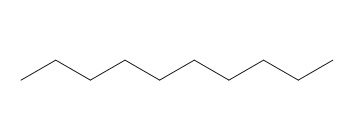Decane
Reference standards.
Inquire / Order:
manager@chemfaces.com
Technical Inquiries:
service@chemfaces.com
Tel:
+86-27-84237783
Fax:
+86-27-84254680
Address:
1 Building, No. 83, CheCheng Rd., Wuhan Economic and Technological Development Zone, Wuhan, Hubei 430056, PRC
Providing storage is as stated on the product vial and the vial is kept tightly sealed, the product can be stored for up to
24 months(2-8C).
Wherever possible, you should prepare and use solutions on the same day. However, if you need to make up stock solutions in advance, we recommend that you store the solution as aliquots in tightly sealed vials at -20C. Generally, these will be useable for up to two weeks. Before use, and prior to opening the vial we recommend that you allow your product to equilibrate to room temperature for at least 1 hour.
Need more advice on solubility, usage and handling? Please email to: service@chemfaces.com
The packaging of the product may have turned upside down during transportation, resulting in the natural compounds adhering to the neck or cap of the vial. take the vial out of its packaging and gently shake to let the compounds fall to the bottom of the vial. for liquid products, centrifuge at 200-500 RPM to gather the liquid at the bottom of the vial. try to avoid loss or contamination during handling.
Food Control2022, 132:108434.
Asian J Beauty Cosmetol2020, 18(3): 265-272.
Antioxidants (Basel).2020, 9(7):581.
J Microbiol Biotechnol.2020, 30(2):178-186.
Molecules.2019, 24(9):E1719
Front Pharmacol.2018, 9:756
Antioxidants (Basel).2023, 12(7):1324.
Revista Brasileira de Farmacognosia2021, 31:794-804.
Front Nutr.2024, 11:1409309.
J Ethnopharmacol.2024, 318(Pt B):116961.
Related and Featured Products
Fuel, 2006, 85(7–8):944-956.
The combustion of kerosene: Experimental results and kinetic modelling using 1- to 3-component surrogate model fuels[Reference:
WebLink]
The oxidation of kerosene Jet-A1 and that of n-Decane have been studied experimentally in a jet-stirred reactor at atmospheric pressure and constant residence time, over the high temperature range 900–1300 K, and for variable equivalence ratio (0.5≤ϕ≤2).
METHODS AND RESULTS:
Concentration profiles of the reactants, stable intermediates, and final products have been obtained by probe sampling followed by on-line and off-line GC analyses. The oxidation of neat n-Decane and of kerosene in these conditions was modeled using a detailed kinetic reaction mechanism (209 species and 1673 reactions, most of them reversible). The present model was successfully used to simulate the structure of a fuel-rich premixed n-Decane–oxygen–nitrogen flame. In the modelling, kerosene was represented by four surrogate model fuels: 100% n-Decane, n-Decane-n-propylbenzene (74%/26% mol), n-Decane-n-propylcyclohexane (74%/26% mol), and n-Decane-n-propylbenzene-n-propylcyclohexane (74%/15%/11% mol).
CONCLUSIONS:
The 3-component model fuel was the most appropriate for simulating the JSR experiments. It was also successfully used to simulate the structure of a fuel-rich premixed kerosene–oxygen–nitrogen flame.



